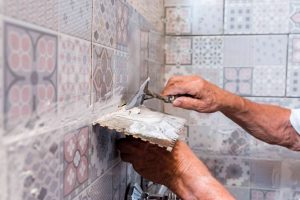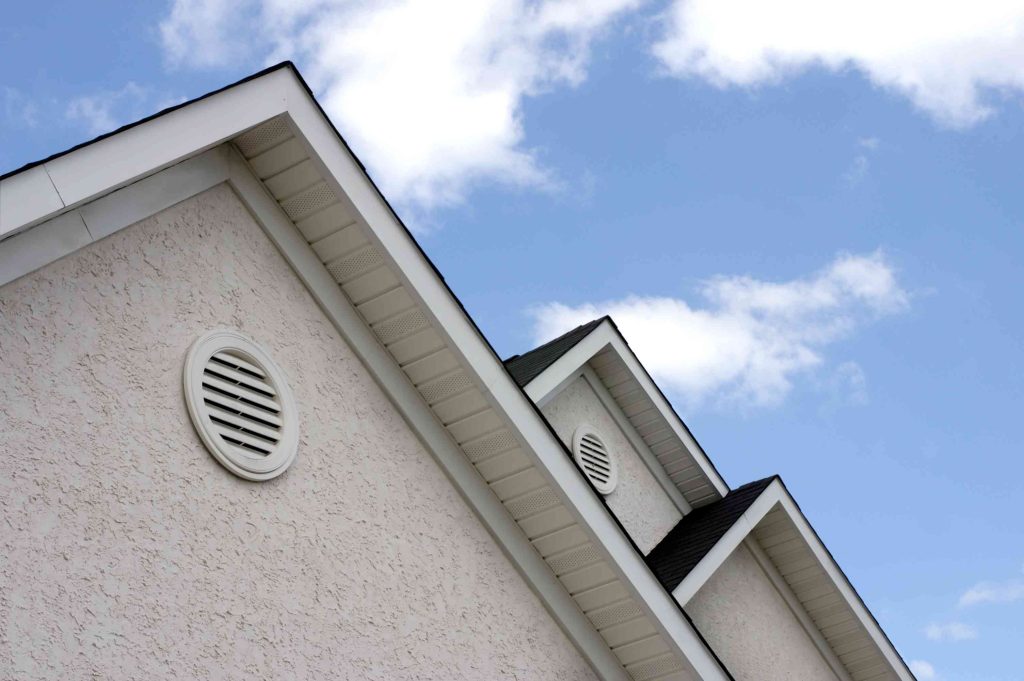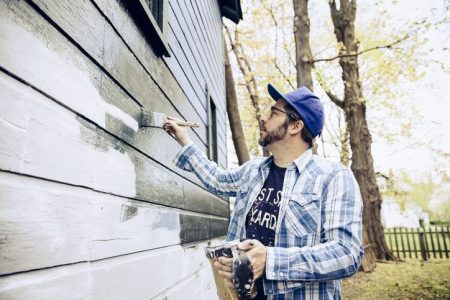When painting stucco, this popular exterior wall surface requires prep work by filling cracks, pre-washing the stucco, and a special back-rolling technique. Stucco is unique from other home exterior surfaces because it is highly textured, coarse, and porous. It’s also durable, affordable, and easily conforms to different surfaces.
There are two types of stucco, traditional and synthetic; both require pre-washing and back rolling. Traditional stucco tends to be more durable and long-lasting, while synthetic stucco has acrylic resin that helps it hold its tint and prevent cracking from temperature fluctuations.
To prep the surface, pressure-wash the stucco. Dirt and debris easily become lodged in the surface of stucco, and pressure washing is the only way to clean it—short of scrubbing the surface by hand. Because stucco is porous, the surface will need back-rolling if you use a paint sprayer. To back roll, spray paint an area, then use a paint roller to roll over the paint while the paint is still wet. Back rolling blends the paint to prevent it from looking patchy and pushes it into the surface pores to promote adhesion.
Read on to learn the steps for painting stucco to ensure long-lasting beauty.
What Is Back Rolling?
Back rolling consists of spraying paint and then following the spray by rolling the paint with a paint roller while the paint is still wet.
The Best Paint for Stucco
Choose flat or satin exterior paint for stucco. Flat paint is more appropriate for the matte look of stucco, and it’s easy to touch up without creating inconsistent spots, known as flashing. Satin can be used because it makes it easier to clean the stucco later on. But satin’s slight gloss accentuates the stucco’s texture, making blending touch-ups more challenging. Stucco works with many types of paint schemes.
What You’ll Need
Equipment / Tools
- Caulking gun
- Latex gloves
- Pressure washer
- Paint sprayer
- Roller frame
- Roller extension pole
- Ladder
- Paint scraper
- Chip brush
- 5-in-1 tool
- Wire brush
Materials
- Masonry caulking
- Exterior latex paint
- Concrete and masonry primer/sealer
- Ready-mix stucco patch
- Thick nap roller covers
- Painter’s tape
- Large sheets of paper or painter’s plastic
Instructions
How to Paint Stucco
-
Inspect the Stucco
Inspect the stucco’s visible structural integrity, including hairline fissures, larger cracks, or holes. Large horizontal cracks may need professional repair.
-
Pressure Wash
Clean the walls. The very tops of walls tend to collect cobwebs and insect nests, while the very bottoms become dirty with splashed mud.
- Plug the pressure washer into a GFCI outlet and attach the hose to a hose bib.
- Power up the washer.
- Wash the stucco siding starting at the top and working downward at a pressure between 1,500 and 2,500 PSI.
- When the water coursing down the wall turns clear, the wall is clean.
- Spray from several angles to clean thoroughly.
-
Scrape Paint
- Start with the paint scraper at the top of the wall and scrape any peeling or loose paint.
- Hold the scraper at a low angle to the wall and gently push forward with the scraper. Do not push at a steep angle or too hard to avoid chipping away the delicate stucco.
-
Fix Cracks and Holes
Fill hairline cracks: Traditional stucco is more prone to cracks and holes, but traditional and synthetic stucco can develop fissures or holes. Fill hairline cracks with caulk.
- Don thick latex gloves.
- Run a thin bead of caulk over the crack.
- Push the caulk into the crack with your finger.
- Dab the caulk with a moistened chip brush to feather it out and blend it with the rest of the stucco.
Fill large cracks: Large cracks are wider than the thickness of the paint scraper blade.
- Scrape out crumbling stucco.
- Fill the crack with caulk deep into the cracks.
Fill holes: Holes require a ready-mix stucco patch.
- Use the 5-in-1 tool to scrape out the hole’s loose stucco.
- Lightly brush out the hole with the wire brush. Exterior stucco has wire backing, so you may need to scrape as deep as that level.
- Fill the hole with a ready-mix stucco patch.
-
Protect Windows And Doors
Use painter’s plastic or paper and painter’s tape to cover windows, doors, and details you don’t want painted to protect them from overspray.
-
Prime Surface
- Pour primer into a lined paint tray.
- Fit a 3/8-inch nap roller cover on a roller frame and screw the extension pole in place.
- Prime all repaired areas, including stucco patches and caulked cracks.
- Be sure to load the primer fairly heavily but not to the point where it drips or causes the roller to lag or slide on the surface.
-
Spray Paint
Use the paint sprayer to spray an area about 8 feet wide by 8 feet high. Spray directly from the front.
-
Randomize Paint
Spray the same section at different, random angles while the paint is still wet. Because stucco has bumps and ridges, spraying from the front alone will leave unpainted small pockmarks and slivers.
-
Back Roll
- While the paint is still wet, back roll or roll over it again with the paint roller.
- Press the paint further into the stucco and blend it.
- For any large missing sections, re-spray and then back roll.
-
Apply Second Coat
Follow the paint manufacturer’s directions for the best temperatures for applying the paint and when to apply a second coat. This will vary based on how cool or moist conditions are.
How to Maintain Stucco
Stucco needs to be inspected once or twice yearly for cracks, holes, discoloration, peeling paint, or mold or dirt buildup. Wash the exterior twice to three times annually to keep it looking its best. Before cleaning, repair cracks to prevent water from damaging the stucco and underlying house structure.
To clean the surface, use water first; you may not need a cleaning agent. But if you notice a stain or mold buildup, dilute bleach with water in a spray bottle and apply it over the stain. Allow the solution to sit on the stain for 10 minutes before washing it away with a pressure washer set on low. If the stain is set in, use a soft bristle brush and scrub the stain with some of the cleaning solution.
When to Call a Professional
For large holes in the stucco or for holes that extend beyond the wire backing, hire a carpenter or contractor to repair the siding and the house’s wall system. Also, if you notice diagonal or stepped cracks, it can signify a structural or foundational issue, such as settling or shifting. A structural engineer or foundation expert would be the best person to diagnose those issues.
Painting stucco can be tricky; it’s not uncommon for property owners to call in experts to repair and paint large stucco projects, mainly since so much prep work is involved.
-
Is painting stucco a good idea?
Besides making an exterior look nice, painting stucco has many benefits, such as keeping out moisture, sealing tiny cracks, resisting UV damage, and covering stains.
-
Is it better to spray or roll paint on stucco?
The best way to apply paint on stucco is to use a roller for small jobs and an airless paint sprayer and roller (back rolling) for larger projects. A paintbrush is only recommended if it’s for a minor touch-up.
-
What are the disadvantages of painting stucco?
The biggest disadvantages of painting stucco include the wait time from the application of stucco to allowing it 60 days to cure, the lengthy prep work process, and the necessity to scrape or strip old paint off before repainting. The cost to paint stucco and the regular maintenance required are other hindrances.
Read the full article here














